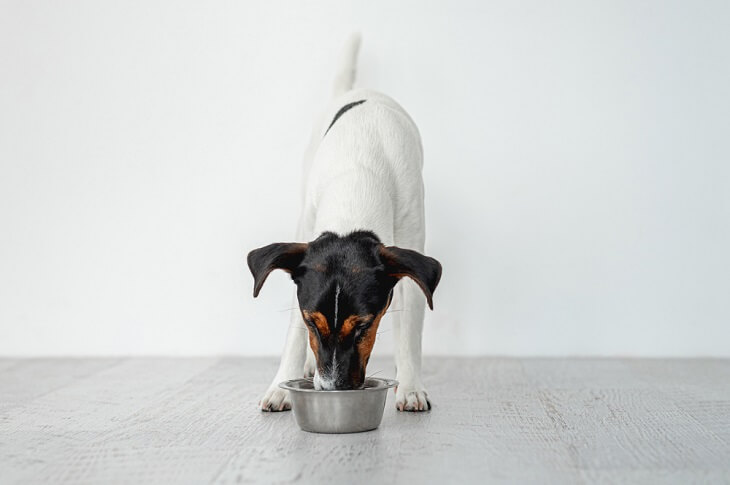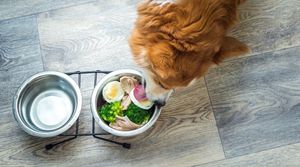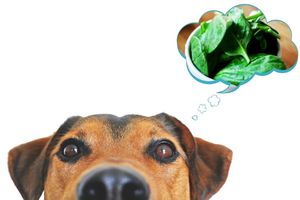If you're in the kitchen preparing the family dinner, your furry friend is probably sitting at your feet, hoping you'll send them a tasty morsel. You're cooking up some Hawaiian-style "Loco Moco" for the family, and you've added a bit too much rice.
You stare down at the dog licking its chops as it gazes up at you. Can dogs eat rice? Is brown or white rice better? Could you mix a bit of it into your pooches food at dinnertime?
Can I feed my dog white rice?
Sure, your dog can eat rice, but should you feed it to them as a responsible pet owner? If you have that extra cup of rice leftover after dinner, should you treat your dog? Dogs love rice, and they're happy to finish off your leftovers if you let them.
The reality is rice isn't harmful to most dogs. Some have allergies to the food, leading to a trip to the vet, but those cases are few and far between. If you're going to feed your dog rice, you have plenty of options.
Rice comes in several varieties. White, brown, red, wild, basmati and many more.
So, can you feed your dog any type of rice? Rice is an excellent source of carbohydrates, providing your pup with energy. Rice also contains loads of fiber, helping keep the digestive tract healthy.
However, if you're going to feed your dog rice, avoid using the white rice variety. White rice is the most refined type, and it typically lacks the same nutrition value as brown and wild varieties.
White rice has the lowest nutritional value of all rice types because of the milling process. White rice feeds nations, and it's a staple on dinner tables across the world, especially in Asia. White rice is like the white bread of the rice world, and it's by far the most popular choice sold in retail stores worldwide.
During the milling process, white rice loses some of its nutritional value. To compensate for this effect, manufacturers add minerals and vitamins back into the rice after milling. However, this process can cause digestive problems when feeding the rice to your dog.
Typically, a few tablespoons of rice mixed in with their food won't cause any harm, and it's a good way to check if your dog has allergies. If you notice any gastric distress or signs of vomiting and diarrhea, it's probably better to avoid feeding your dog white rice.

Can I give my dog brown rice?
So, what about brown rice? Can you feed it to your dog? Sure, you can feed brown rice to your dog.
Brown rice doesn't undergo any refining process, and it's a healthy source of fiber, vitamins, and minerals for your dog.
Brown rice doesn't experience the same vitamin-deficiency treatment as white rice, so it's less likely to cause digestive distress.
Brown rice is actually healthy for your dog. The fiber keeps the digestive system in good shape, enhancing your dog's metabolism and immune system.
Brown rice is exceptionally high in vitamins B and D, which help build strong bones and teeth while optimizing metabolic health in your pooch.
Here are a few benefits of feeding your dog brown rice.
Brown rice is the best choice for dogs, providing beneficial health advantages. However, we recommend avoiding feeding your dog rice every day. Rice is a carb-heavy meal ingredient, and it can add weight to your dog, making them obese.
Can dogs eat red rice?
Red rice is another alternative to brown rice that is also suitable for your dog's dinner bowl. Red rice also goes by the name "Cargo Rice." It has a similar structure to brown rice, meaning it's unpolished. Red rice has a deep red or purple color to the grain, and it's a popular foodstuff around the world.
Red cargo rice is harder to find than brown rice, and it requires a longer cooking time. Typically, red rice is chewy, with a firmer texture than brown rice. We recommend softening the rice by leaving it in a bowl for 30-minutes to soak before cooking. The rice absorbs the water during the soak, making it softer after cooking.
Red rice is a long-grain, non-glutinous type of rice, and the "cargo" term originates from the shipping of the food to nations around the world using bulk transport. Merchants would package the rice down into smaller quantities for sale on the retail market. White and brown rice typically receives packaging by the manufacture in manageable portions before transport to the market.
Red rice does undergo a minor milling process that removes the husks. However, it undergoes no polishing process, leaving the vitamins and minerals intact in the germ and bran layer.
Red rice is an excellent source of thiamin (vitamin B1) and riboflavin (vitamin B2), as well as a great source of fiber and beneficial minerals like calcium and iron. Red rice has a nuttier and sweeter taste compared to brown rice, with a rougher mouthfeel.
You can feed your dog red rice once or twice a week without any adverse digestive effects.
White or brown rice for dogs?
So, what kind of rice is for dogs? From the information so far, it's easy to see that brown or red rice are the better options for your dog.
However, let's compare brown rice to white rice to find out the pros and cons of each for your pet.
We'll start off by looking at feeding white rice to dogs:
And now let's have a detailed look at the pros and cons of feeding brown rice to your dog.
How much rice can you give a dog?
Now that you know it's safe to feed your dog rice and the best types of rice to use, it's time to look at how you can add it to your dog's dinner bowl. Before you start feeding your dog large quantities of rice, check if they have any allergies to the food. Mix a small bit of rice into its evening meal, and see how the dog responds.
If your dog has allergies to rice, it may show up in the following symptoms: skin itching, hair loss or patchy coats or ear infections.
Some breeds are exceptionally sensitive to food items. If your dog is an adult and you start feeding them rice for the first time, it may cause adverse reactions in the gut that lead to digestive issues.
It might surprise you to learn that rice is already a part of many dog food products by leading brands. However, it's all about the balance of feeding them the right amount of rice. Any rice in small amounts is almost harmless to your dog, except for foods like onions, garlic, and chocolate.
Follow the 10% rule when feeding your dog rice. That is, never make more than 10% of the meal ingredients rice.
White rice is a calorie-dense food, with white rice containing 45 carbs per cup, or 206 calories per serving. Brown rice contains 216 calories per cup, with 45 carbs.
However, brown rice has more fiber at 3.5-grams per cup, compared to 0.6-grams for white rice.




